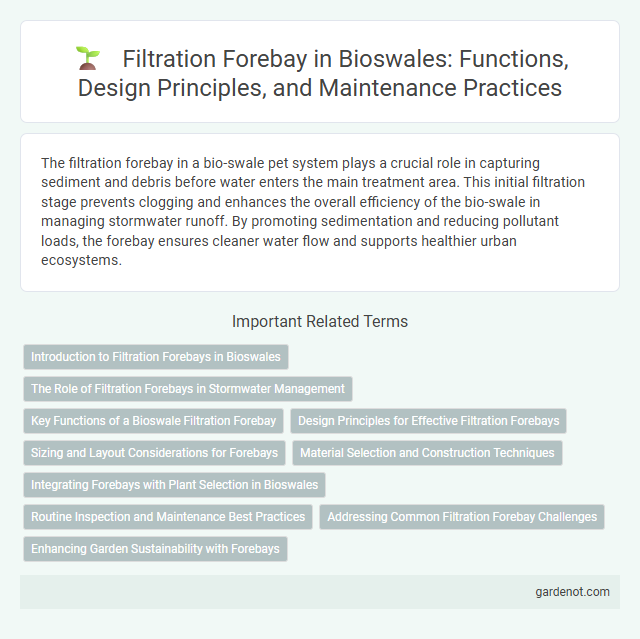The filtration forebay in a bio-swale pet system plays a crucial role in capturing sediment and debris before water enters the main treatment area. This initial filtration stage prevents clogging and enhances the overall efficiency of the bio-swale in managing stormwater runoff. By promoting sedimentation and reducing pollutant loads, the forebay ensures cleaner water flow and supports healthier urban ecosystems.
Introduction to Filtration Forebays in Bioswales
Filtration forebays in bioswales serve as primary sedimentation zones designed to capture coarse particulates and debris before water enters the main bioswale. These engineered depressions enhance water quality by reducing sediment load, preventing clogging, and promoting the efficiency of downstream biofiltration processes. Incorporating vegetation and engineered media in filtration forebays optimizes pollutant removal and supports long-term bioswale performance.
The Role of Filtration Forebays in Stormwater Management
Filtration forebays serve as critical pre-treatment structures within bio-swale systems, capturing sediment, debris, and pollutants from stormwater runoff before it enters the main infiltration area. By reducing sediment loads, these forebays enhance the efficiency and longevity of downstream bio-filtration processes, preventing clogging and promoting groundwater recharge. Proper design and maintenance of filtration forebays are essential to optimize urban stormwater management and improve water quality outcomes.
Key Functions of a Bioswale Filtration Forebay
A bioswale filtration forebay primarily captures and settles large sediment and debris before water enters the bioswale, reducing clogging and enhancing pollutant removal efficiency. It promotes sedimentation of particulates, prevents erosion, and provides initial treatment by slowing water velocity. Effective forebay design improves overall stormwater quality by protecting downstream bioswale components and maintaining hydraulic performance.
Design Principles for Effective Filtration Forebays
Filtration forebays in bio-swales should be designed with adequate sedimentation zones to capture coarse particles and prevent clogging downstream, enhancing overall pollutant removal efficiency. Incorporating stable, non-erodible materials and vegetation aids in structural integrity and sediment capture, while providing easy access for regular maintenance extends the forebay's functional lifespan. Proper sizing based on watershed area and sediment load ensures optimal retention time, preventing sediment resuspension and promoting effective filtration.
Sizing and Layout Considerations for Forebays
Proper sizing of a filtration forebay is critical to ensure effective sediment capture and facilitate maintenance within a bio-swale system, typically designed to hold 10-15% of the total water volume from the contributing drainage area. Layout considerations prioritize placement at the inflow point to maximize sediment deposition, with dimensions often scaled to provide a surface area large enough for sediment settling while maintaining adequate flow velocity. Incorporating features such as sediment traps, baffles, and easy access for sediment removal enhances the long-term functionality and performance of the forebay in stormwater management.
Material Selection and Construction Techniques
The filtration forebay in a bio-swale relies on durable, permeable materials such as crushed stone and geotextiles to enhance sediment capture and promote efficient water infiltration. Construction techniques prioritize proper layering and compaction to prevent erosion and ensure long-term structural stability. Selecting corrosion-resistant metals and biodegradable components further supports sustainable performance and ease of maintenance.
Integrating Forebays with Plant Selection in Bioswales
Filtration forebays in bioswales serve as critical sedimentation zones that capture coarse particles before water enters the main treatment area, enhancing overall water quality. Integrating forebays with strategic plant selection involves using deep-rooted native species that improve sediment stabilization and nutrient uptake, promoting effective filtration. This synergy between physical sediment capture and biological treatment maximizes pollutant removal and supports sustainable stormwater management.
Routine Inspection and Maintenance Best Practices
Routine inspection of the filtration forebay in a bio-swale involves checking for sediment accumulation, erosion, and blockages to ensure optimal water flow and filtration efficiency. Maintenance best practices include regularly removing trapped debris and sediment, repairing any structural damages promptly, and replenishing vegetation to maintain soil stability and filtration capacity. Consistent monitoring and timely maintenance reduce the risk of clogging and improve long-term pollutant removal performance.
Addressing Common Filtration Forebay Challenges
Filtration forebays are critical for sediment capture and pollutant removal in bio-swale systems, yet they often face clogging and sediment accumulation challenges. Implementing routine maintenance schedules and using engineered media layers improves water flow and extends forebay functionality. Employing vegetation with robust root systems further stabilizes sediment and enhances filtration efficiency.
Enhancing Garden Sustainability with Forebays
Filtration forebays in bio-swales play a crucial role in enhancing garden sustainability by capturing and settling sediment and debris before water enters the main filtration area. These structures reduce pollutant loads, improve water quality, and promote healthier plant growth within garden ecosystems. Integrating filtration forebays ensures efficient stormwater management while supporting long-term soil and plant vitality.
Filtration forebay Infographic

 gardenot.com
gardenot.com